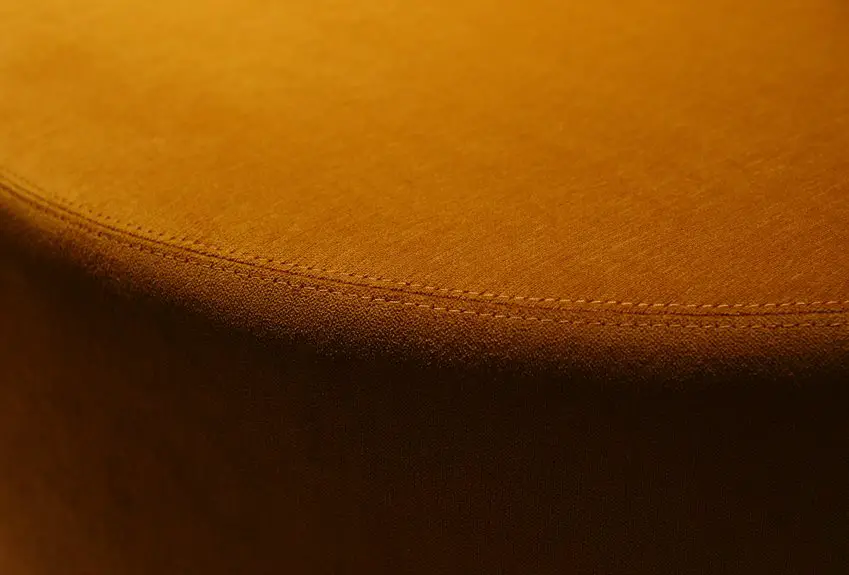You might think finding a fabric that’s both incredibly soft and remarkably durable is like searching for a unicorn. Yet, some natural fabrics come close to that ideal. Cotton, bamboo, and hemp each offer unique benefits that can transform your wardrobe. But what happens when you blend these fibers? The answer could change how you view comfort and longevity in clothing. Let’s explore the possibilities.
Table of Contents
Key Takeaways
- Cotton-bamboo blends offer exceptional softness and breathability while maintaining durability, making them ideal for comfortable wear.
- Hemp is one of the strongest natural fibers, providing impressive durability without sacrificing softness when properly processed.
- Linen is highly durable and breathable, although it may wrinkle easily, it softens with each wash for added comfort.
- Wool retains shape and resilience, making it durable while offering a soft feel against the skin.
- Blending fabrics like cotton with Tencel enhances durability while keeping the softness and breathability intact.
Exploring the Softness of Natural Fabrics
When you touch natural fabrics, you might immediately notice their unique softness, which sets them apart from synthetic materials. This softness often comes from the fibers’ natural structure, like cotton’s fluffy fibers or silk’s smooth surface.
Each fabric type offers a distinct feel; for instance, linen has a crisp texture, while modal feels almost creamy against your skin. You can also find that many natural fabrics become softer with each wash, enhancing your comfort over time.
Whether you’re snuggling into a cotton blanket or wearing a silk shirt, you’ll appreciate the gentle embrace of these materials. Their breathability adds to the overall experience, making natural fabrics a go-to choice for comfort-loving individuals.
The Durability Factor: Which Fabrics Last Longer?
Natural fabrics not only offer incredible softness but also vary considerably in durability. When you’re looking for longevity, some fabrics stand out.
For instance, hemp is known for its impressive strength and resistance to wear and tear, making it a top choice for long-lasting items. Linen, while softer, is also durable, though it can wrinkle easily.
Cotton can be sturdy, especially when woven tightly, but it tends to wear out faster than hemp or linen. On the other hand, wool is resilient, holding its shape well and resisting fraying.
Comparing the Comfort and Breathability of Fabrics
How do different fabrics stack up in comfort and breathability?
When you’re looking for soft, natural fabrics, cotton and bamboo stand out. Cotton’s breathable fibers wick moisture away, keeping you cool during warm days. It feels soft against your skin, making it a popular choice for casual wear.
Bamboo, on the other hand, is incredibly soft and has natural antibacterial properties. It’s known for excellent moisture-wicking capabilities, providing comfort even in humid conditions.
Linen, while slightly rougher, excels in breathability due to its loose weave, allowing air to circulate freely.
Each fabric offers unique comfort and breathability benefits, so consider your needs and climate when making a choice. Ultimately, it’s about finding the right balance for your lifestyle.
The Sustainability of Soft and Durable Fabrics
Choosing fabrics that aren’t only comfortable but also sustainable is increasingly important. By opting for soft and durable natural fabrics, you contribute to a healthier planet.
Opt for comfortable and sustainable natural fabrics to make a positive impact on the planet.
Here are some factors to evaluate when contemplating sustainability:
- Renewable resources: Look for fabrics made from crops that replenish quickly, like cotton or hemp.
- Biodegradability: Confirm the fabric can decompose naturally, reducing landfill waste.
- Low environmental impact: Choose options that require less water and chemicals during production.
- Ethical production: Support companies that prioritize fair labor practices and transparency.
- Longevity: Invest in durable fabrics that last, minimizing the need for frequent replacements.
Ideal Fabric Blends for Maximum Softness and Strength
What makes a fabric both soft and strong? The key lies in the right blends. Combining natural fibers like cotton, bamboo, and linen can yield a luxurious softness while maintaining durability.
For instance, a cotton-bamboo blend offers breathability and moisture-wicking properties, ensuring comfort without sacrificing strength. Adding a touch of hemp or Tencel can enhance durability, creating fabrics that withstand wear while still feeling gentle against your skin.
You might also consider blends with a small percentage of spandex for added elasticity, allowing for a snug fit without compromising comfort.
Frequently Asked Questions
How Do I Care for Soft Natural Fabrics?
Caring for soft natural fabrics is like nurturing a delicate flower. You’ll want to wash them gently, avoid harsh detergents, and air dry to maintain their softness and longevity. Treat them with love for lasting beauty.
Can Softness Affect the Durability of a Fabric?
Yes, softness can affect a fabric’s durability. Softer materials might wear out faster under stress, while stiffer options often resist wear better. It’s essential to balance comfort with longevity when choosing your fabrics.
Are There Hypoallergenic Natural Fabrics Available?
Yes, there are hypoallergenic natural fabrics available. Cotton, bamboo, and linen are great options. They’re less likely to irritate your skin, making them perfect for sensitive individuals or those prone to allergies.
What Are the Best Uses for Soft yet Durable Fabrics?
You can use soft yet durable fabrics for various applications, like cozy bedding, comfortable clothing, or stylish upholstery. They provide comfort and longevity, making them ideal for everyday items that withstand wear while feeling great against your skin.
How Do Different Dyes Affect Fabric Softness and Durability?
Dyes dance upon fabric, transforming its essence. Different dyes can either enhance or compromise softness and durability. You’ll find natural dyes often maintain fabric integrity better, while synthetic ones might introduce harshness and weaken fibers.
- How to Use a Percolator: A Beginner’s Step-by-Step Guide - July 14, 2025
- What Is Percale Cotton? A Refresher on the Basics - July 14, 2025
- What Fabric Is Percale? A Simple Explanation for Shoppers - July 14, 2025







